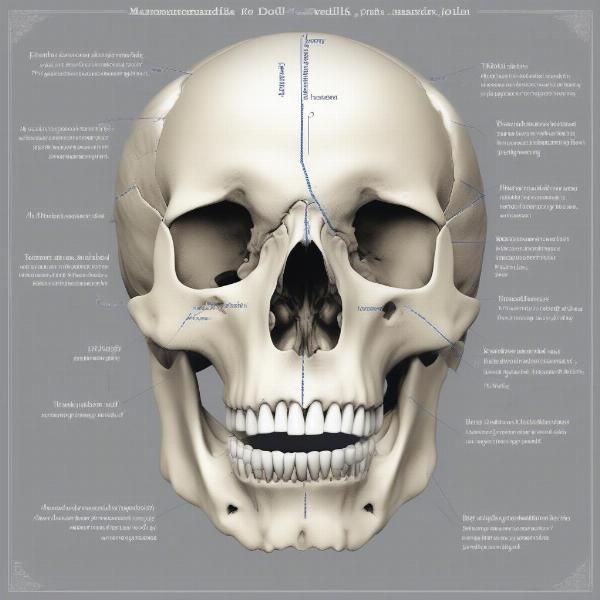The dog jawbone, a crucial part of your canine companion’s anatomy, plays a vital role in eating, playing, and overall well-being. Understanding its structure and potential problems is essential for responsible dog ownership. This article will cover everything from basic anatomy to common jawbone issues and how to ensure your dog’s jaw stays healthy.
Dog Jawbone Anatomy and Function
A dog’s jawbone is composed of the mandible (lower jaw) and the maxilla (upper jaw). The mandible is a single bone, while the maxilla is paired. These bones house the teeth and provide attachment points for the powerful muscles responsible for chewing and biting. The temporomandibular joint (TMJ) connects the mandible to the skull, allowing for movement and flexibility. This complex structure enables dogs to perform essential functions like prehending food, chewing, and defending themselves.
 Dog Jawbone Anatomy
Dog Jawbone Anatomy
Common Dog Jawbone Problems
Several issues can affect a dog’s jawbone, ranging from developmental problems to injuries and diseases. Some common problems include:
- Fractures: Jaw fractures can occur due to trauma, such as being hit by a car or biting on a hard object.
- Temporomandibular Joint Disorders (TMJD): TMJD can cause pain, clicking sounds, and difficulty chewing.
- Osteomyelitis: This is a bone infection that can be painful and require long-term treatment.
- Tumors: While less common, tumors can affect the jawbone and require specialized veterinary care.
- Dislocated Jaw: dog with dislocated jaw This is a painful condition where the jawbone slips out of its normal position in the TMJ.
Maintaining Your Dog’s Jawbone Health
Proactive care can significantly contribute to your dog’s jawbone health. Here are some key strategies:
- Provide a balanced diet: A nutritious diet with appropriate levels of calcium and phosphorus is crucial for strong bones.
- Offer appropriate chew toys: Chewing helps strengthen jaw muscles and can prevent tartar buildup. Avoid extremely hard toys that could fracture teeth or the jaw.
- Regular dental care: plaque cleaner for dogs Good dental hygiene helps prevent infections that could spread to the jawbone.
- Regular veterinary checkups: Your veterinarian can identify potential jawbone issues early on, increasing the chances of successful treatment.
- Avoid rough play: While play is essential, discourage activities that could lead to jaw injuries.
Recognizing Signs of Jawbone Problems in Dogs
Early detection of jawbone problems is vital for effective treatment. Look for the following signs:
- Difficulty eating or chewing
- Drooling excessively
- Swelling or pain around the jaw
- Reluctance to play with toys
- Changes in behavior, such as whimpering or aggression
- Bad breath or bleeding gums which might indicate the need for dog teeth removal
If you notice any of these signs, consult your veterinarian immediately.
Conclusion
The dog jawbone is a complex and vital part of a dog’s anatomy. Understanding its structure, potential problems, and how to maintain its health is crucial for responsible dog ownership. By being proactive and attentive to your dog’s needs, you can help ensure a healthy and happy life for your furry friend. Regular checkups and providing a balanced diet are key to preventing and addressing any potential jawbone problems.
FAQ
- What are the most common causes of jaw fractures in dogs? Trauma, such as being hit by a car or falling from a height, is a common cause.
- How is TMJD diagnosed in dogs? A veterinarian will perform a physical exam and may recommend X-rays or other imaging tests.
- Can a dog live with a missing tooth? Yes, dogs can adapt to missing teeth, but dental care is essential to prevent further issues.
- How long does a dog jawbone take to heal after a fracture? Healing time can vary but generally takes several weeks.
- What can I do to prevent jawbone problems in my dog? Providing a balanced diet, appropriate chew toys, and regular dental care can help prevent many jawbone issues.
- What are the signs of a dislocated jaw in a dog? Difficulty closing the mouth, drooling, and pain are common signs.
- Are certain dog breeds more prone to jawbone issues? Some breeds, like brachycephalic breeds, may be more prone to certain jawbone problems. how long does dog dental cleaning take
ILM Dog is your trusted resource for expert advice on all aspects of dog care, from breed selection and health to training, nutrition, grooming, and more. We offer valuable insights into maintaining your dog’s well-being, including information on jawbone health, false teeth for dogs, and other dental concerns. Contact us for any inquiries: Email: [email protected], Phone: +44 20-3965-8624. ILM Dog is dedicated to helping you provide the best possible care for your canine companion.